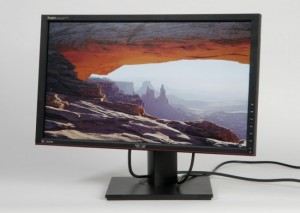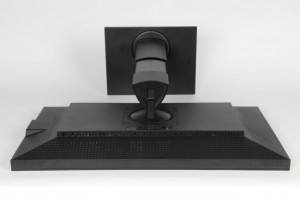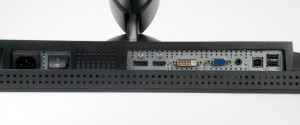Monitors on the IPS-matrix are confidently striding towards cheaper solution – in the last year of the most popular models cost around $ 200-220, which is slightly higher than that of TN-monitors. But such a pricing policy is not the best way of affecting the equipment: in fact, these models have started up “under the knife” everything but the screen, and the user receives a high-quality image, framed frankly in the Budget. Fortunately, there are exceptions, and in this case, here is a model ASUS PA238Q, which is completely equipped with IPS to match the quality matrix.

Externally ASUS PA238Q is radically different from the typical cost of monitors – a massive stand, strict straight lines and no gloss. Most of the design of this model resembles some monitors … Dell (eg, 2209WA), that in the eyes of a number of users will be a definite plus.
The body of ASUS PA238Q is made of black matte plastic frame surrounds the screen centimeter width where the upper left corner there is the logo line ProArt. The control buttons and menu navigation – mechanical, not touch, are located on the right side of the face. The power indicator is located under the power button – a small square (almost a “pixel”), which glows with white light during operation and orange – in standby mode. The only tribute to the design of ASUS PA238Q is thin red line, emphasizing logos ASUS, HDMI and Display Port. Also worth noting centimeter and inch ruler along the edges of the screen, and which are barely noticeable notch – it can be useful to designers, but using them is not very convenient, because consider the strokes is very difficult.

The monitor ASUS PA238Q has used LED-backlight, so the thickness of the screen is relatively small, though larger than the budget models.
ASUS PA238Q is equipped with a full set of video inputs – Display Port, HDMI, DVI and VGA. On the rear panel there is a USB-hub ports and 2 USB 2.0; two more are on the side, on the left side. In addition, the back reveals a mechanical power switch – a thing in these times is extremely rare. Sound made by HDMI or Display Port, can be output to headphones via the audio output mini-jack.
Of course, the main thing that attracts the attention in this monitor ASUS PA238Q a massive stand. The monitor weighs an impressive 5.5 kg (2 times more than the models in the price range of ~ $ 200), and move it without serious effort impossible. The foot also gives the impression of its dimensions – a real bar, which allows you to adjust the screen position adjustment, change the angle, turn the display on its axis, and translate the screen to portrait mode.
At the base of legs, by the way, also plotted scale, which measures the angle of rotation – to be honest, the practical value of this solution seems very doubtful, most likely it is done for the sake of design.

In general, the design turned stiff appreciably undermine the monitor will not work even specifically – from this point of view, it is made on the five plus.
Optionally, you can disconnect the stand – the screws are covered with rubber caps – and hang the monitor on the wall.
Menu
Overall, the menu is similar to the monitor ASUS VS239N. The main section is again brand Splendid, which contains various display modes (quick switching between them, without calling the menu by using the buttons combined S / A). In the “Color” can adjust the brightness, contrast, select one of the color temperature, etc. (Some items may not be available depending on the selected mode in the menu Splendid – for example, sRGB only allowed to change the brightness.) Here, in the Under “Advanced Settings”, fine adjustment of colors available (changing hue, saturation, gain, and offset color), but the average user, configure, monitor “by eye”, without special equipment, we would recommend not to touch anything there. In the “Image” you can adjust the sharpness, screen format, as well as a number of other options that are available for different types of connection. Also here it is possible to configure proprietary TraceFree, allowing reducing the response time by supplying a higher voltage in the initial stage of changing the orientation of the crystals. Note here that the maximal value of this parameter appears distinct artifacts in the form of “phantom” tails stretching of moving objects. The optimal value will be “60” – artifacts are practically absent, and the grease becomes less pronounced. In “Setting PIP” you can use modes Picture-in-Picture (“PIP”) and Picture-by-Picture (“picture next to the picture”) to output signals from two video inputs simultaneously, and adjust their position on the screen. “Selecting Input” expected, offers the possibility to switch between video inputs. One last item – “System Settings”, contains provisions for the OSD menu language selection interface, reset to factory settings, and some other options. As in the ASUS VS239N in this model, there is a mode QuickFit (called using the top button labeled as “screen with a ruler”). In it possible to display the centimeter and inch mesh, and the contours of documents of different sizes (A4, Letter, etc.).
Inside the ASUS PA238Q:
This monitor uses IPS-matrix (the manufacturer does not specify the type, but apparently, it’s e-IPS) with a 23″, 16:9 aspect ratio and the native “resolution of 1920×1080 pixels”. Claimed response time – 6ms (GtG), with the help of technology TraceFree, which was mentioned above, the matrix, according to the manufacturer, you can “drive” to the value of 2 ms (GtG), 5 ms (on / off). As mentioned above, the maximum value of this parameter are clearly noticeable the artifacts, but they are missing the middle position, with little visible grease, and the monitor is quite suitable for dynamic games and even more so – to view videos.
ASUS PA238Q model is factory calibrated picture mode sRGB, as evidenced by the attached to each copy of the report. Measurements confirm it really – the image in additional correction is almost not needed, and the average user after selecting this mode will actually need only adjust the brightness of the picture for you. Thus, the graph is almost linear range and only slightly below the standard value of 2.2. Colour temperature a bit too high – 7000K practically the whole range, except for very dark areas, where the deviation from the norm is not critical.
In the “Standard”, user can change the brightness / contrast / color temperature / range, with enhanced color settings are not available to him. Unfortunately, the entire setting range is reduced to the choice of one of two options – 2.2 and 1.8, the possibility of fine tuning, this parameter is not present. We would recommend to lower the contrast to the specified value in the 80 to 60 – in this case the picture is much more pleasant eye and gamma curve rises slightly, although still remains at or slightly above 2.1.
Mode “Theatre” offers a very peculiar contrast settings – frankly exaggerated in dark areas and also much too low – in light, which is clearly seen in the graph of the gamma curve – it begins with the level of 2.7 in the dark areas and almost linearly decreases to 1.7 in the light. In fact, it gives a very rich picture (perhaps too), but the detail in the bright areas are not affected.
Minimum brightness of ASUS PA238Q is quite low – 53 cd / m ² (at maximum contrast). Max, however too small – 190 cd / m ². Uniformity of illumination at brightness of 100% from the measurements of nine points was 93% – a very good result. At least this was a bright upper left corner, the most striking – the center and bottom right, and the difference between them was 29 cd / m ², that quite a bit for LED-backlight.
In the sRGB contrast adjustment is not available, the brightness is set to 100% – with the average value were quite moderate, 115 cd / m ². Empirically determined that the contrast with the stands at ~ 52%.
Matte screen surface, respectively, crystal effect, but there is not too much. As the viewing angle in the horizontal plane brightness decreases evenly and slightly in the vertical – with deviation of 45 degrees reducing the brightness of serious, with further variations in display brightness increases slightly. Also, the angle begins to show a purple hue, especially noticeable on a black background.
Results
ASUS PA238Q impresses through a rigorous design and excellent design stand. The quality of the image, it is at a high level, but the fundamental differences between the cheap IPS-models could be found, so that the average cost of $ 350 in our market is somewhat overpriced – at a cost of up to $ 300 it would be a very attractive option for the purchase.
Pros:
+ Good image quality
+ Factory Calibration
+ High performance, rigidity and functional support
Cons:
– Price is a bit too high
